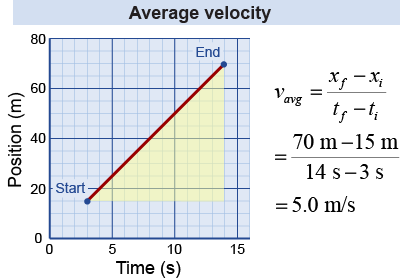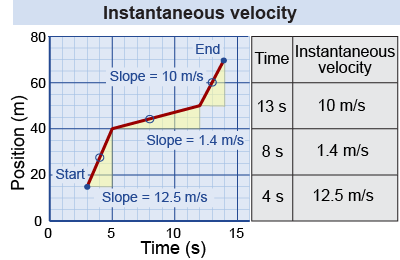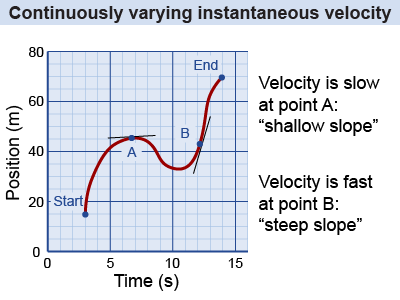|
Earlier in this chapter, velocity was defined as the rate of change of position with time, v = Δx/Δt. In many simple cases this is expressed as (xf − xi) divided by (tf − ti). But what happens when the velocity changes between the initial and final times, such as repeatedly speeding up and slowing down? What is the velocity of a car during stop-and-go driving? 
|
 The answer involves the difference between average and instantaneous velocity. The average velocity is the total displacement (or distance) traveled divided by the total time taken. In the figure shown, the total distance traveled is 55 m. The total time taken is 11 s. The average velocity is the ratio of the two: 55 m/11 s = 5.0 m/s. This calculation uses equation (3.4).
The answer involves the difference between average and instantaneous velocity. The average velocity is the total displacement (or distance) traveled divided by the total time taken. In the figure shown, the total distance traveled is 55 m. The total time taken is 11 s. The average velocity is the ratio of the two: 55 m/11 s = 5.0 m/s. This calculation uses equation (3.4). 
|
| (3.4) | | | vavg | = | average velocity (m/s) | | xf | = | final position (m) | | xi | = | initial position (m) | | tf | = | final time (s) | | ti | = | initial time (s) |
| Average velocity
|
|
 Now imagine that the car is being driven through traffic—speeding up and slowing down. The position–time graph might be similar to the figure on the right. The instantaneous velocity is the velocity of the car at any particular moment. The instantaneous velocity may be faster than average or slower than average. The speedometer on a car’s dashboard reads instantaneous speed, not the average speed over your entire trip.
Now imagine that the car is being driven through traffic—speeding up and slowing down. The position–time graph might be similar to the figure on the right. The instantaneous velocity is the velocity of the car at any particular moment. The instantaneous velocity may be faster than average or slower than average. The speedometer on a car’s dashboard reads instantaneous speed, not the average speed over your entire trip. 
 |


|
The instantaneous velocity at any moment is the slope of the position versus time graph at that moment. In the example, at time t = 4 s the instantaneous velocity is v = 12.5 m/s. At time t = 5 s, the graph shows that the car slows down. At time t = 8 s, the car’s instantaneous velocity is v = 1.4 m/s. 
 |
 In real-world cases, the instantaneous velocity might not vary suddenly (as in the previous example), but smoothly. After all, you don’t usually slam on the brakes suddenly! The instantaneous velocity is the tangent to the curve in a position–time graph, as is shown in the figure at right. When the tangent to the curve has a shallow slope, the instantaneous velocity is small. When the tangent to the curve has a steep slope, the instantaneous velocity is large. Can you find a location on the graph where the instantaneous velocity is negative?
In real-world cases, the instantaneous velocity might not vary suddenly (as in the previous example), but smoothly. After all, you don’t usually slam on the brakes suddenly! The instantaneous velocity is the tangent to the curve in a position–time graph, as is shown in the figure at right. When the tangent to the curve has a shallow slope, the instantaneous velocity is small. When the tangent to the curve has a steep slope, the instantaneous velocity is large. Can you find a location on the graph where the instantaneous velocity is negative? 
|
Most of the equations in this chapter are used in the context of average velocity, because they are evaluated between two positions at two times. In a more complicated case, however, such as the trip from Houston to College Station, the average velocity differed from the instantaneous velocity because the car traveled, stopped, moved again, and then turned around. Is there any single correct velocity to describe that motion? The answer depends on the problem you are asked. The average velocity was 80 km/hr on the outbound trip whereas the instantaneous velocity was 100 km/hr while driving and 0 km/hr while stopped. 
 |
The speedometer of a car shows the speed at that particular moment of time and hence it is the instantaneous speed. If you looked at the odometer of the car and measured how many miles you traveled, looked at your watch to determine the total time taken, and divided one by the other, then you would be calculating the average speed. 
|
Kim runs at a constant velocity of 3 m/s for 5 s. She then stops to rest for 5 s. What is her average velocity over the whole 10 s? - 5 m/s
- 3 m/s
- 6 m/s
- 1.5 m/s
 |
Kim’s average velocity was d, 1.5 m/s, since 
|

